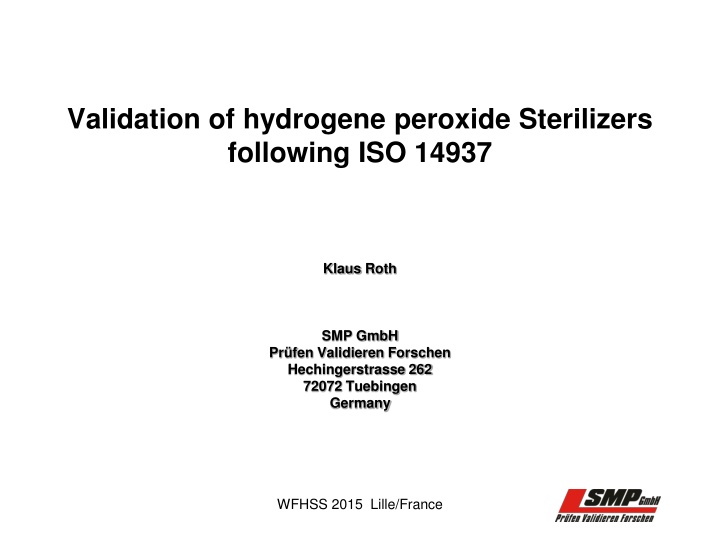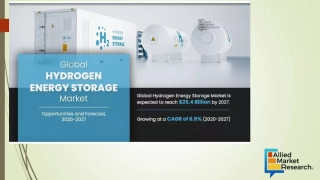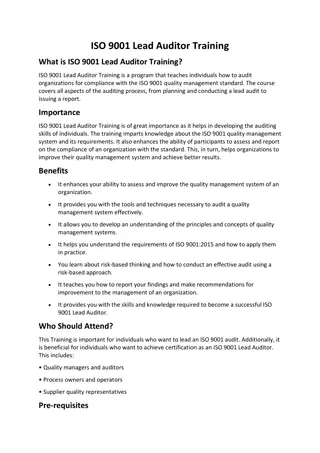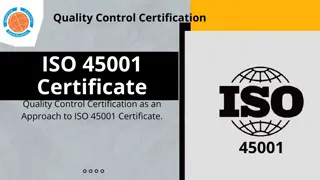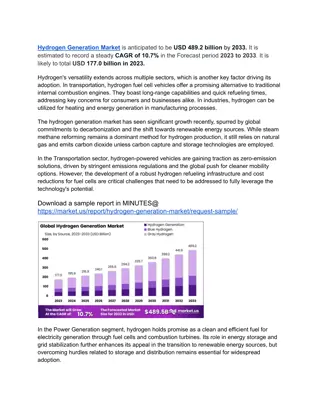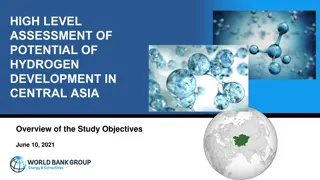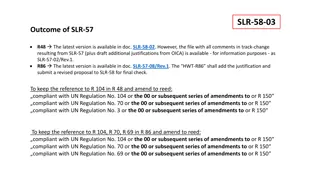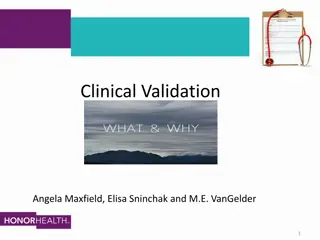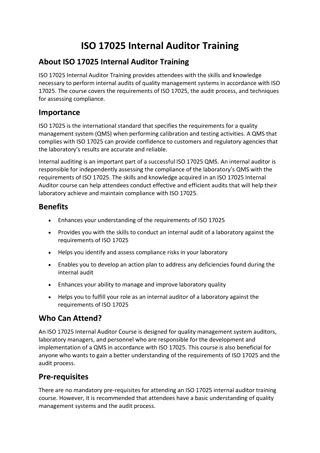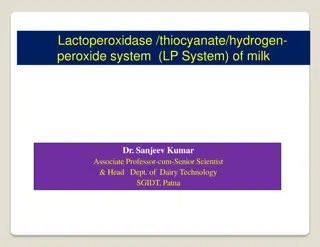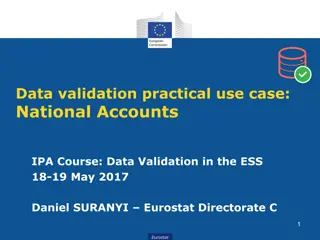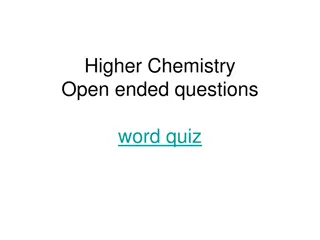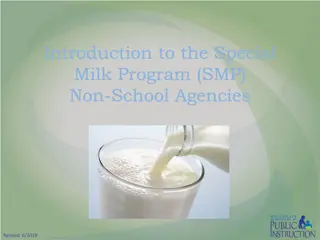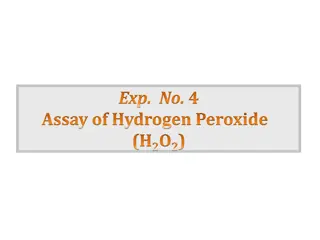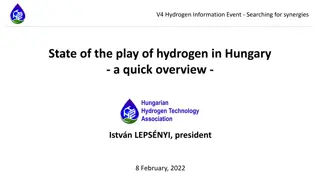Validation of Hydrogen Peroxide Sterilizers Following ISO 14937 - Klaus Roth SMP GmbH
Klaus Roth SMP GmbH in Tuebingen, Germany specializes in the validation of cleaning, disinfection, and sterilization processes, with a focus on different sterilization methods such as steam, ethylene oxide, formaldehyde, and hydrogen peroxide. They conduct research in prions, test new instrument designs, and evaluate cleaning and disinfection agents. The company adheres to ISO 14937:2009 requirements for characterizing a sterilizing agent and developing and validating sterilization processes for medical devices, using criteria like test organism selection, D-Value definition, and indicator testing.
Download Presentation

Please find below an Image/Link to download the presentation.
The content on the website is provided AS IS for your information and personal use only. It may not be sold, licensed, or shared on other websites without obtaining consent from the author.If you encounter any issues during the download, it is possible that the publisher has removed the file from their server.
You are allowed to download the files provided on this website for personal or commercial use, subject to the condition that they are used lawfully. All files are the property of their respective owners.
The content on the website is provided AS IS for your information and personal use only. It may not be sold, licensed, or shared on other websites without obtaining consent from the author.
E N D
Presentation Transcript
Validation of hydrogene peroxide Sterilizers following ISO 14937 Klaus Roth SMP GmbH Pr fen Validieren Forschen Hechingerstrasse 262 72072 Tuebingen Germany WFHSS 2015 Lille/France
Fields of activities: Validation of the cleaning processes Validation of disinfection processes Validation of sterilization processes Validation of instrument behaviour with respect to Steam sterilization Ethylenoxide sterilization Formaldehyde sterilization Hydrogene peroxide sterilization Research in the field of prions Testing of new instruments designs Testing of cleaning agents Testing of disinfection agents WFHSS 2015 Lille/France
ISO 14937:2009 Sterilization of health care products -- General requirements for characterization of a sterilizing agent and the development, validation and routine control of a sterilization process for medical devices WFHSS 2015 Lille/France
ISO 14937:2009 Requirements: 1. Selection of the test organism 2. Definition of the D-Value of the organism 3. Biological Indicators following ISO 11138 4. Chemical Indicators following ISO 11140 5. Pass-Fail criterias WFHSS 2015 Lille/France
Selection of the test organism Geobacillus stearothermophillus is well accepted to test hydrogene peroxide sterilization processes. A minimum of 106cfu per indicator should be used, when the sterilizer is running in half cycle mode. All microorganisms have to be killed in half cycle mode WFHSS 2015 Lille/France
Definition of the D-Value of the test organism In microbiology, D-value refers to decimal reduction time and is the time required at a given temperature to kill 90% of the exposed microorganisms. The term is used in assessing microbial thermal resistance and thermal death time analysis. Thus after a colony is reduced by 1 D, only 10% of the original organisms remain, i.e., the population number has been reduced by one decimal place in the counting scheme. Generally, each lot of a sterilization-resistant organism is given a unique D-value. When referring to D-values it is proper to give the temperature as a subscript of the "D". For example, given a hypothetical organism which is reduced by 90% after exposure to temperatures of 300 F for 20 minutes, the D-value would be written as D300F= 20 minutes. D-value determination is often carried out to measure a disinfectant's efficiency to reduce the number of microbes present in a given environment.[1] (Wikipedia) WFHSS 2015 Lille/France
Definition of the D-Value Cycle in a resistometer for steam ISO 18472 Cycle in a steam sterilizer WFHSS 2015 Lille/France
Definition of the D-Value The cycles in a steam sterilizer are well established. Different types of cycles are known: Subatmospheric Transatmospheric Super atmospheric The preparation time is not defined. Only the plateau phase is defined by time, temperature and pressure WFHSS 2015 Lille/France
Definition of the D-Value Sterilization cycles in a H O sterilizer: Each manufacturer has designed his own cycle. Some manufacturer have the same cycle for all models and adapt the amount of H O to the size of the chamber. Some manufacturer has an individual cycle for each model We found cycles with One injection phase Two injection phases Four injection phases The individual design of the sterilization phase has to be regarded when setting up a resistometer for H O sterilization. We found in reports D-values between 0.56 min and 6 min. WFHSS 2015 Lille/France
Biological Indicators following ISO 11138 Depending of the carrier material biological indicators failed Also the same indicators but from differnet lots showed different behavior WFHSS 2015 Lille/France
Chemical Indicators following ISO 11140 Most of the chemical indicators had already a complete color change after the half cycle WFHSS 2015 Lille/France
Pass-Fail criterias Temperature Humidity Insufficient vacuum Low amount of hydrogene peroxide Load Combination of failures WFHSS 2015 Lille/France
Pass-Fail criterias Temperature Temperature was set on a lower level (2 C beneath the warning level given by the manufacturer) Acceptance criteria: BI has to pass in half cycle mode If the BI fails in halfcycle mode the CI has to fail in full cycle mode CI has to fail in half cycle mode WFHSS 2015 Lille/France
Pass-Fail criterias Humidity Depending on the possible load for the sterilizer a wet fabrics was placed inside the chamber. The amount of water was increased until the sterilizer was going into failure mode. The BI s and CI s of the cycle were evaluated using the same criterias as mentioned before. WFHSS 2015 Lille/France
Pass-Fail criterias Insufficient vacuum Vacuum was set on a higher level (above the warning level given by the manufacturer) The BI s and CI s of the cycle were evaluated using the same criterias as mentioned before. WFHSS 2015 Lille/France
Pass-Fail criterias Low amount of hydrogene peroxide Cycles were run with a lower portion of hydrogen peroxide Also Hydrogen peroxide at the end of the shelf live was used The BI s and CI s of the cycle were evaluated using the same criterias as mentioned before. WFHSS 2015 Lille/France
Pass-Fail criterias Combination of failures Simulated Failures all together have been run with empty and full chamber The BI s and CI s of the cycle were evaluated using the same criterias as mentioned before. WFHSS 2015 Lille/France
Pass-Fail criterias Load The sterilizers have been loaded with silicone mats and/or other materials. The size of the load was depending on the results of the BI s. Sterilization has been performed in half cycle mode. Example for challenge pack WFHSS 2015 Lille/France
Sterilizer tested since 2000 Manufacturer 1 2 3 4 Sterilizer 1 2 3 4 5 6 7 8 9 Comparable Cycle of the different sterilizer models x x x Plasma phase x x x x x x x x Pre-heating x x x x x x x Concentration of H O x x x Parametric control with calculated concentration of H O Parametric control including measurement of H O x x x x x x x x x WFHSS 2015 Lille/France
Bioindicators used for the tests WFHSS 2015 Lille/France
Testing of the spore suspension Incubation ofthe TSB eluate2) CFU /Inoculated location4) CFU / plate1) Identification3) Sample No. Inoculated location 54%-1 1 0 + G. stearotherm. 0 54%-2 1 7 + G. stearotherm. <10 54%-3 1 20 + G. stearotherm. >20 27%-1 1 >300 + G. stearotherm. >300 27%-2 1 >300 + G. stearotherm. >300 27%-3 1 >300 + G. stearotherm. >300 13.5%-1 1 Lawn growth + G. stearotherm. >1000 13.5%-2 1 Lawn growth + G. stearotherm. >1000 13.5%-3 1 Lawn growth + G. stearotherm. >1000 WFHSS 2015 Lille/France
Influence of the temperature WFHSS 2015 Lille/France
Conclusion Some H O processes have shown good sterilization behavior even against prions The use of ISO 14937 as a guidance for the IQ, OQ, PQ process for H O sterilizer has limitations as not all requirements can be fulfilled (resistometer etc. is missing) Indicator has to be designed for each specific cycle The load of the sterilizer has to be defined in details. Deviations in material weight and surface area of the load may lead to a reduction of the safety of the process PCD s should simulate not only the geometry but also the material of the instruments Specific standards for H O sterilizers and the accessories is needed WFHSS 2015 Lille/France
Nice to have and a must for a Hydrogene Peroxide Sterilizer Comparable Cycle of the different sterilizer models Not only at the end of the cycle also at the beginning as preconditioning of the load Preheated load seems to have an important role to avoid condensation of the sterilizing Nice to have Plasma phase Pre-heating agent Nice to have Concentration of H O to improve the performance with respect of the material Parametric control with calculated concentration of H O Parametric control including measurement of H O Surveillance of the sterilizing agent is a requirement by the standard Delivers additional information about the sterilizing agent inside the chamber and take into account the interaction with the load WFHSS 2015 Lille/France
Thank you very much SMP GmbH Hechingerstrasse 262 72072 T bingen WFHSS 2015 Lille/France
